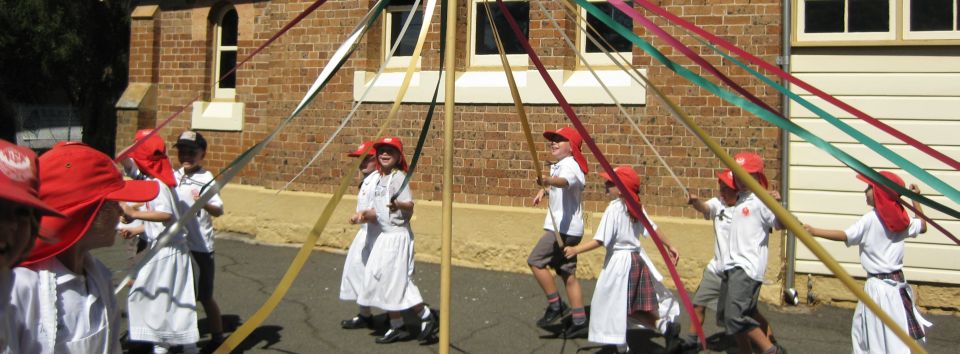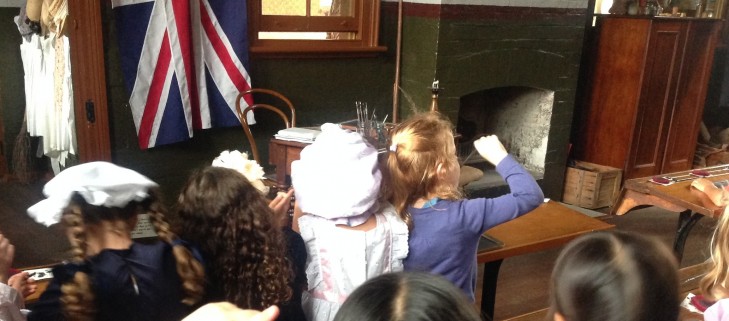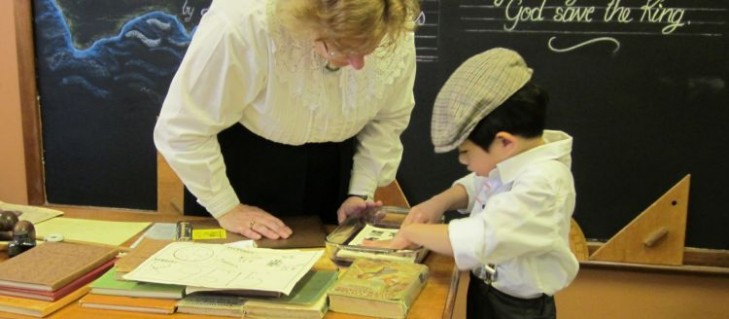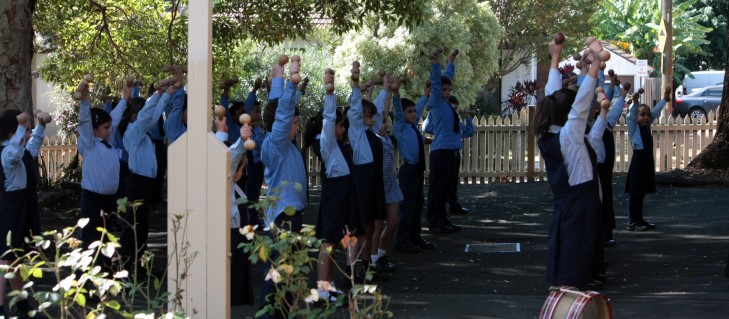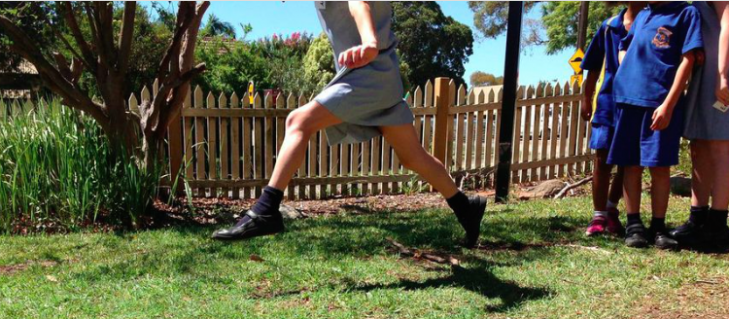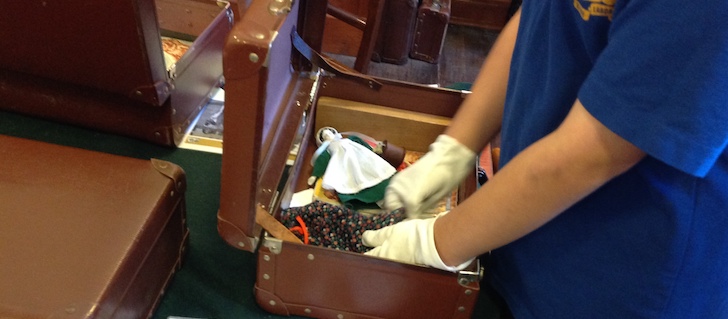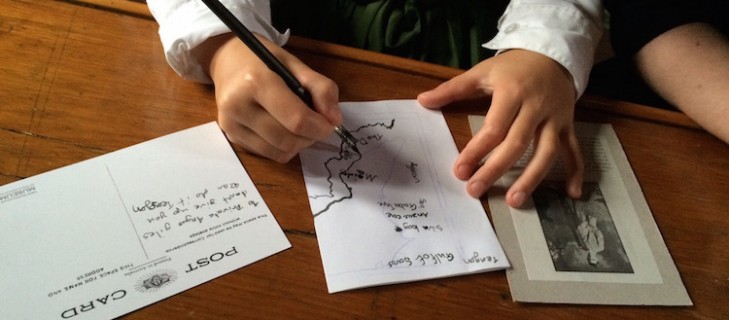Typical Visit
Also on this page:
- Typical visit for Stage 1 – School Days of the Past
- Typical visit for Stage 2 – Continuity and Change
- Wet weather
- Facilities
- Medical matters
- Toast
Arrival and Departure Times
Most schools arrive around 10.00am and have a quick morning tea outdoors, ready to start the sessions by 10.25am. In winter, students collect kindling for the fire during this time. If two or three Stage 1 classes the program concludes at 1.00pm for lunch, with most schools staying to have lunch and a play in the grounds. The Stage 2 programs, and four class Stage 1 day, conclude at 2.00pm, with lunch between sessions.
A typical visit includes three or four 45 to 55 minute sessions, depending on the stage and student numbers.
Typical Visit for Stage 1 – School Days of the Past
1880s re-created lesson – seated at long-toms, the students re-enact aspects of daily lessons to gain an understanding of aspects of schooling in the past. The session includes chanting tables, writing with slate pencils on slate boards, using an early reader, viewing original 1880s pupils’ work, and writing Copperplate with pen and ink.
Interactive activities – students engage with artefacts through activities such as finding objects and treasures, using rubber stamps and a jelly pad, examining contents of Globite school cases, studying photographs, playing with early puzzles and toys and, in winter, eating toast cooked over the fire.
Drill and maypole dancing – students learn simple maypole dancing, dressed in pinafores or sailor collars if they wish. They undertake precision exercises using wands or dumb-bells.
Playground chants and games – students play schoolyard games such as skipping, ‘fly’, quoits and bowling hoops. If four classes, they also learn some simple chants and play circle games.
Sample visit plans – download a sample excursion plan for Stage 1 School Days of the Past: Stage 1 – two classes, Stage 1 – three classes, Stage 1 – four classes.
Social story – download the Stage 1 social story to share with your students. This is in an inclusive format for students of all abilities.
Typical Visit for Stage 2 – Continuity and Change
1880s re-created lessons – seated at original long-toms and forms, the students take part in aspects of 1880s daily lessons to gain an understanding of education in the past. Students will chant tables, write with slate pencils on slate boards, read from an early reader and write Copperplate with pen and ink. They will examine original 1880s pupils’ work and an early school punishment book to consider changes and continuities in learning and discipline.
1900s-1970s school resources investigation – students work as ‘history detectives’ through activities such as finding and interacting with objects and treasures, examining contents of Globite school cases and studying photographs. In role as students from the past, they print from a jelly pad, label a map using pen and ink and do craft such as twisted threads, weaving or knitting. In winter they toast a piece of bread over the fire.
1900s drill and maypole dancing – students learn precision exercises using wands and can wear lacy or sailors’ collars when learning simple maypole dancing.
1960s lessons and games – students experience a short session in our recreated 1960s classroom where they observe the layout and use Cuisenaire Rods to complete number sentences. They play ‘fly’ or skipping with a long rope on the grass outside the room.
Sample visit plans – download a sample excursion plan for Stage 2 Continuity and Change – two classes, Stage 2 Continuity and Change – three classes and Stage 2 Continuity and Change – four classes.
Adverse weather
In rain, extreme heat or poor air quality some outdoor sessions are run in a modified format indoors. Students may do drill indoors and may do craft or an activity with Cuisenaire rods in our recreated 1960s room. If raining, maypole dancing will be omitted. If four groups in wet weather, the program may run as a three session rotation due to space limitations.
Facilities
For school groups there is a block of toilets, an undercover outdoor eating area and grassy grounds for playing. There are no tea and coffee making facilities. Take-away coffee can be purchased nearby in Cox’s Road or BYO thermos.
Medical Matters
Schools must bring their own first aid kit and emergency medications for their students. All museum staff are trained in e-Emergency, anaphylaxis and emergency asthma procedures. An Epi-Pen, first aid kit and Ventolin reliever is located on site.
Toast
White bread and golden syrup are used for toasting. Download images of the ingredient panels and packages.
Schools should supply alternative bread for students with special dietary requirements. Students with coeliac disease will be able to toast their own gluten free bread first using clean equipment.
Resources
Pre and post visit learning, information sheets, souvenirs, photo galleries and other links are on our Resources page.
Typical Visit for Stage 2 – School Children and the Anzacs
We have paused this program for 2023 and 2024.
1915 Assembly – the day commences with a recreated 1915-1918 assembly where students will hear news of local soldiers, sing God Save the King and patriotic songs, recite an oath and salute the flag.
The Gallipoli Landing – in the context of a 1915 school day, students will trace a map of Gallipoli using pen and ink, write a postcard to a soldier at the front and decode Morse Code.
The Home Front – in role as 1915 school pupils, students spin fleece into yarn, copy a verse of support to a soldier, roll and fold bandages as Red Cross members, use metal WW1 toy soldiers and blocks to create a 3D model of a military camp and weigh vegetables for fundraising.
Junior Cadet Training – in role as junior cadets, students will practise drill commands and marching, learn some letters and signals using semaphore flags. Additionally they will dress up to recreate an Empire Day tableau.
Sample excursion plans will be available when we reinstate the program.
Explore the supporting learning resource NSW School Children and the Anzacs.

